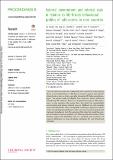| dc.contributor.author | Lei Chang, Hui Jing Lu, Jennifer E Lansford, Marc H Bornstein, Laurence Steinberg, Bin-Bin Chen, Ann T Skinner, Kenneth A Dodge, Kirby Deater-Deckard, Dario Bacchini, Concetta Pastorelli, Liane Peña Alampay, Sombat Tapanya, Emma Sorbring, Paul Oburu, Suha M Al-Hassan, Laura Di Giunta, Patrick S Malone, Liliana Maria Uribe Tirado, Saengduean Yotanyamaneewong | |
| dc.description.abstract | The external environment has traditionally been considered as the primary
driver of animal life history (LH). Recent research suggests that animals’
internal state is also involved, especially in forming LH behavioural phenotypes. The present study investigated how these two factors interact in
formulating LH in humans. Based on a longitudinal sample of 1223 adolescents in nine countries, the results show that harsh and unpredictable
environments and adverse internal states in childhood are each uniquely
associated with fast LH behavioural profiles consisting of aggression, impulsivity, and risk-taking in adolescence. The external environment and internal
state each strengthened the LH association of the other, but overall the external environment was more predictive of LH than was the internal state. These
findings suggest that individuals rely on a multitude and consistency of
sensory information in more decisively calibrating LH and behavioural
strategies | en_US |

